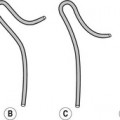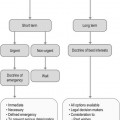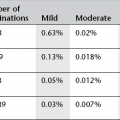Liver, biliary tract and pancreas
Methods of imaging the hepatobiliary system
1. Plain film
2. Ultrasound (US):
3. CT including:
(a) Routine ‘staging’ (portal venous phase) CT
(b) Triple phase ‘characterization’ CT
(c) CT cholangiography
4. MRI
5. Endoscopic retrograde cholangiopancreatography (ERCP)
6. Percutaneous transhepatic cholangiography (PTC)
7. Operative cholangiography
8. Postoperative (T-tube) cholangiography
9. Angiography – diagnostic and interventional
10. Radionuclide imaging:
Plain films
May be useful to demonstrate air within the biliary tree or portal venous system, opaque calculi or pancreatic calcification.
Ultrasound of the liver
Indications
1. Suspected focal or diffuse liver lesion
2. Jaundice
3. Abnormal liver function tests
4. Right upper-quadrant pain or mass
5. Hepatomegaly
6. Suspected portal hypertension
7. Staging known extrahepatic malignancy
8. Pyrexia of unknown origin
9. To facilitate the placement of needles for biopsy, etc.
10. Assessment of portal vein, hepatic artery or hepatic veins
11. Assessment of patients with surgical shunts or transjugular intrahepatic portosystemic shunt (TIPS) procedures
12. Follow-up after surgical resection or liver transplant.
Patient preparation
Not imperative, but fasting or restriction to clear fluids only required if the gallbladder is also to be studied.
Equipment
3–5-MHz transducer and contact gel. Selection of the appropriate pre-set protocol and positioning of focal zone will depend upon the type of machine, manufacturer and patient habitus.
Technique
1. Patient supine
2. Time-gain compensation set to give uniform reflectivity throughout the right lobe of the liver
3. Suspended inspiration
4. Longitudinal scans from epigastrium or left subcostal region across to right subcostal region. The transducer should be angled up to include the whole of the left and right lobes
5. Transverse scans, subcostally, to visualize the whole liver
6. If visualization is incomplete, due to a small or high liver, then right intercostal, longitudinal, transverse and oblique scans may be useful. Suspended respiration without deep inspiration may allow useful intercostal scanning. In patients who are unable to hold their breath, real-time scanning during quiet respiration is often adequate. Upright or left lateral decubitus positions are alternatives if visualization is still incomplete
7. Contrast-enhanced ultrasound of the liver uses microbubble agents to enable the contrast enhancement pattern of focal liver lesions, analogous to contrast-enhanced CT or MRI, to be assessed and thus to characterize them. It requires specific software on the ultrasound machine. The lesion to be interrogated is identified on conventional B mode scanning and then the scanner is switched to low mechanical index (to avoid bursting the bubbles too quickly) contrast-specific scanning mode with a split screen to allow the contrast-enhanced image to be simultaneously viewed with the B mode image. The images are recorded after bolus injection of the contrast agent flushed with saline.
Additional views
Hepatic veins
These are best seen using a transverse intercostal or epigastric approach. During inspiration, in real time, these can be seen traversing the liver to enter the inferior vena cava (IVC). Hepatic vein walls do not have increased reflectivity in comparison to normal liver parenchyma. The normal hepatic vein waveform on Doppler is tri-phasic reflecting right atrial pressures. Power Doppler may be useful to examine flow within the hepatic segment of the IVC since it is angle-independent.
Portal vein
The longitudinal view of the portal vein is shown by an oblique subcostal or intercostal approach. Portal vein walls are of increased reflectivity in comparison to parenchyma. The normal portal vein blood flow is towards the liver. There is usually continuous flow but the velocity may vary with respiration.
Hepatic artery
This may be traced from the coeliac axis, which is recognized by the ‘seagull’ appearance of the origins of the common hepatic artery and splenic artery. There is normally forward flow throughout systole and diastole with a sharp systolic peak.
Common bile duct
See below in ‘Ultrasound of the gallbladder and biliary system’.
Spleen
The spleen size should be measured in all cases of suspected liver disease or portal hypertension. Ninety-five percent of normal adult spleens measure 12 cm or less in length, and less than 7 × 5 cm in thickness. The spleen size is commonly assessed by ‘eyeballing’ and measurement of the longest diameter.1 In children, splenomegaly should be suspected if the spleen is more than 1.25 times the length of the adjacent kidney, normal ranges have also been tabulated according to age and sex.1,2
References
1. Loftus, WK, Metreweli, C. Ultrasound assessment of mild splenomegaly: spleen/kidney ratio. Pediatr Radiol. 1998; 28(2):98–100.
2. Megremis, SD, Vlachonikolis, IG, Tsilimigaki, AM. Spleen length in childhood with US: normal values based on age, sex, and somatometric parameters. Radiology. 2004; 231(1):129–134.
Claudon, M, Dietrich, CF, Choi, BI, et al. Guidelines and Good Clinical Practice Recommendations for Contrast Enhanced Ultrasound (CEUS) in the Liver-Update 2012: A WFUMB-EFSUMB Initiative in Cooperation With Representatives of AFSUMB, AIUM, ASUM, FLAUS and ICUS. Ultrasound Med Biol. 2013; 39(2):187–210.
Kono, Y, Mattrey, RF. Ultrasound of the liver. Radiol Clin North Am. 2005; 43(5):815–826.
Shapiro, RS, Wagreich, J, Parsons, RB, et al. Tissue harmonic imaging sonography: evaluation of image quality compared with conventional sonography. Am J Roentgenol. 1998; 171(5):1203–1206.
Ultrasound of the gallbladder and biliary system
Equipment
3–5-MHz transducer and contact gel. Selection of the appropriate pre-set protocol and positioning of focal zone will depend upon the type of machine, manufacturer and patient habitus. A stand-off may be used for a very anterior gallbladder.
Technique
1. The patient is supine.
2. The gallbladder can be located by following the reflective main lobar fissure from the right portal vein to the gallbladder fossa
3. Developmental anomalies are rare but the gallbladder may be intrahepatic or on a long mesentery. In the absence of a previous cholecystectomy the commonest cause for a non-visualized gallbladder is when a gallbladder packed with stones is mistaken for a gas-filled bowel (usually duodenal) loop.
4. The gallbladder is scanned slowly along its long axis and transversely from the fundus to the neck leading to the cystic duct.
5. The gallbladder should then be re-scanned in the left lateral decubitus or erect positions because stones may be missed if only supine scanning is performed.
6. Visualization of the neck and cystic ducts may be improved by head-down tilt.
The normal gallbladder wall is never more than 3-mm thick.
Additional views
Assessment of gallbladder function
1. Fasting gallbladder volume may be assessed by measuring longitudinal, transverse and antero-posterior (AP) diameters.
2. Normal gallbladder contraction reduces the volume by more than 25%, 30 min after a standard fatty meal. Somatostatin, calcitonin, indometacin and nifedipine antagonize this contraction.
Intrahepatic bile ducts
1. Left lobe: transverse epigastric scan
2. Right lobe: subcostal or intercostal longitudinal oblique.
Normal intrahepatic ducts are visualized with modern scanners. Intrahepatic ducts are dilated if their diameter is more than 40% of the accompanying portal vein branch. There is normally acoustic enhancement posterior to dilated ducts but not portal veins. Dilated ducts have a beaded branching appearance.
Extrahepatic bile ducts
1. The patient is supine or in a lateral position.
2. The upper common duct is demonstrated on a longitudinal oblique, subcostal or intercostal scan running anterior to the portal vein. The right hepatic artery is often seen crossing transversely between the two.
3. The common duct may be followed downwards along its length through the head of the pancreas to the ampulla and, when visualized, transverse scans should also be performed to improve detection of intraduct stones. However, gas in the duodenum often impedes the view of the lower duct.
The segment of bile duct proximal to the junction with the cystic duct (the common hepatic duct) is 4 mm or less in a normal adult; 5 mm is borderline and 6 mm is considered dilated. The lower bile duct (common bile duct) is normally 6 mm or less. Distinction of the common hepatic duct from the common bile duct depends on identification of the junction with the cystic duct. This is usually not possible with US. Colour-flow Doppler enables quick distinction of bile duct from ectatic hepatic artery. In less than one-fifth of patients the artery lies anterior to the bile duct.
Ultrasound of the pancreas
Equipment
3–5-MHz transducer and contact gel. Selection of the appropriate pre-set protocol and positioning of focal zone will depend upon the type of machine, manufacturer and patient habitus. A stand-off may be required in thin patients.
Technique
1. The patient is supine.
2. The body of the pancreas is located anterior to the splenic vein in a transverse epigastric scan.
3. The transducer is angled transversely and obliquely to visualize the head and tail.
4. The tail may be demonstrated from a left intercostal view using the spleen as an acoustic window.
5. Longitudinal epigastric scans may be useful.
6. The pancreatic parenchyma increases in reflectivity with age, being equal to liver reflectivity in young adults.
7. Gastric or colonic gas may prevent complete visualization. This may be overcome by left and right oblique decubitus scans or by scanning with the patient erect. Water may be drunk to improve the window through the stomach and the scans repeated in all positions. One cup is usually sufficient. Degassed water is preferable.
The pancreatic duct should not measure more than 3 mm in the head or 2 mm in the body.
Endoscopic US (see p. 78) and intraoperative US are useful adjuncts to transabdominal US. EUS may be used to further characterize and biopsy pancreatic solid and cystic lesions. Intraoperative US is used to localize small lesions (e.g. islet cell tumours prior to resection).
Computed tomography of the liver and biliary tree
Indications
1. Suspected focal or diffuse liver lesion
2. Staging known primary or secondary malignancy
3. Abnormal liver-function tests
4. Right upper-quadrant pain or mass
5. Hepatomegaly
6. Suspected portal hypertension
7. Characterization of liver lesion
8. Pyrexia of unknown origin
9. To facilitate the placement of needles for biopsy, etc.
10. Assessment of portal vein, hepatic artery or hepatic veins
11. Assessment of patients with surgical shunts or transjugular intrahepatic portosystemic shunt (TIPS) procedures
12. Follow-up after surgical resection or liver transplant.
Technique
Single-phase (portal phase) contrast-enhanced CT
This is the technique for the majority of routine liver CT imaging. The liver is imaged during the peak of parenchymal enhancement, i.e. when contrast-medium-laden portal venous blood is perfusing the liver. This begins about 60–70 s after the start of a bolus injection. Oral contrast may be given but is not necessary if only the liver is being investigated. Slice thickness will depend upon the CT scanner specification but should be 5 mm or less.
Multiphasic contrast-enhanced CT
The fast imaging times of helical/multislice CT enable the liver to be scanned multiple times after a single bolus injection of contrast medium. Most primary liver tumours receive their blood supply from the hepatic artery, unlike normal hepatic parenchyma, which receives 80% of its blood supply from the portal vein. Liver tumours (particularly hypervascular tumours) will therefore enhance strongly during the arterial phase (beginning 20–25 s after the start of a bolus injection) but are of similar or lower density to enhanced normal parenchyma during the portal venous phase (washout). Some tumours are most conspicuous during early-phase arterial scanning (25 s after the start of a bolus injection), others later, during the late arterial phase 35 s after the start of a bolus injection. Thus a patient who is likely to have hypervascular primary or secondary liver tumours should have an arterial phase scan as well as a portal venous phase CT scan (see above). Early and late arterial phase with portal venous phase is appropriate for patients with suspected hepatocellular cancer (triple phase). In general, late arterial and portal venous scans are appropriate to investigate suspected hypervascular metastases. Some centres, however, also use a ‘delayed’ or ‘equilibrium’ phase scan at 180 seconds to help identify and characterize primary liver tumours (quadruple phase). Terminology may be potentially confusing as some centres may consider a triple phase scan to include arterial, portal and delayed scans. Non-contrast examinations have limited usefulness.
Haemangiomas often show a characteristic peripheral nodular enhancement and progressive centripetal ‘fill-in’. After the initial dual- or triple-phase protocol, delayed images at 5 and 10 min are obtained through the lesion.
Computed tomographic cholangiography
Magnetic resonance (MR) cholangiography is non-invasive but sometimes fails to display the normal intrahepatic ducts. Multidetector CT cholangiography can be useful in this instance. With this technique the biliary tree is opacified using an i.v. cholangiographic agent. Isotropic data from 0.625 mm section thickness slices can be reconstructed to provide high-resolution three-dimensional images. Insufficient opacification may be seen with excessively dilated ducts.
Technique
1. Patient fasted for at least 6 h.
2. 100 ml i.v. cholangiographic agent, e.g. meglumine iotroxate (biliscopin R) infused for 50 min as a biliary contrast1 or iodipamide meglumine 52% – 20 ml diluted with 80 ml of normal saline infused over 30 min.2
3. CT scan should be obtained at least 35 min after infusion of contrast agent.
References
1. Hyodo, T, Kumano, S, Kushihata, F, et al. CT and MR cholangiography: advantages and pitfalls in perioperative evaluation of biliary tree. Br J Radiol. 2012; 85(1015):887–896.
2. Schindera, ST, Nelson, RC, Paulson, EK, et al. Assessment of the optimal temporal window for intravenous CT cholangiography. Eur Radiol. 2007; 17(10):2531–2537.
Francis, IR, Cohan, RH, McNulty, NJ, et al. Multidetector CT of the liver and hepatic neoplasms: effect of multiphasic imaging on tumor conspicuity and vascular enhancement. Am J Roentgenol. 2003; 180(5):1217–1224.
Oto, A, Tamm, EP, Szklaruk, J. Multidetector row CT of the liver. Radiol Clin North Am. 2005; 43(5):827–848.
Computed tomography of the pancreas
Technique
1. Negative (e.g. water) oral contrast is generally preferred but positive (e.g. iodinated) may be given if necessary to opacify distal bowel loops. Positive oral contrast agent is contraindicated if CT angiography is to be performed. Volume and timing of oral contrast agent will depend upon whether opacification of distal bowel loops is required.
2. Venous access is obtained.
3. The patient is scanned supine and a scout view is obtained.
4. A non-contrast-enhanced examination can be performed initially if detection of subtle calcification is required.
5. The volume of i.v. contrast used will depend upon the type of scanner. Faster acquisition will allow a smaller volume of contrast, generally 100 ml or less. The timing of the scan in relation to i.v. contrast will depend upon the clinical question. Pancreatic phase enhancement (40 s after commencement of bolus injection) is necessary for optimum contrast differences between pancreatic adenocarcinoma and normal pancreatic tissue, with portal venous phase scans included in the protocol to investigate hepatic metastatic disease. Islet cell tumours and their metastases may show avid enhancement on arterial phase scans and become isodense with normal pancreatic tissue on portal phase scans. A portal phase scan is generally necessary to investigate flow and the relationship of the tumour to the portal vein.
6. The volume and strength of the i.v. contrast will depend upon the speed of the scanner.
7. Slice thickness should be 3 mm or less.
Fletcher, JG, Wiersema, MJ, Farrell, MA, et al. Pancreatic malignancy: value of arterial, pancreatic, and hepatic phase imaging with multi-detector row CT. Radiology. 2003; 229(1):81–90.
Goshima, S, Kanematsu, M, Kondo, H, et al. Pancreas: optimal scan delay for contrast-enhanced multi-detector row CT. Radiology. 2006; 241(1):167–174.
Magnetic resonance imaging of the liver
Stay updated, free articles. Join our Telegram channel

Full access? Get Clinical Tree






